Analysis of Computer Systems and Sustainability
VerifiedAdded on 2021/04/17
|14
|3475
|162
AI Summary
The provided document offers a detailed examination of computer systems, emphasizing their capacity to rapidly transfer data between memory locations. It delves into the concept of sustainability, discussing resource depletion in life cycle assessments and sustainable behavior in businesses. The assignment also touches upon lean manufacturing, continuous improvement processes, and the significance of shifting data in microprocessors. Additionally, it evaluates sustainable business model archetypes and provides references to relevant research papers and studies.
Contribute Materials
Your contribution can guide someone’s learning journey. Share your
documents today.
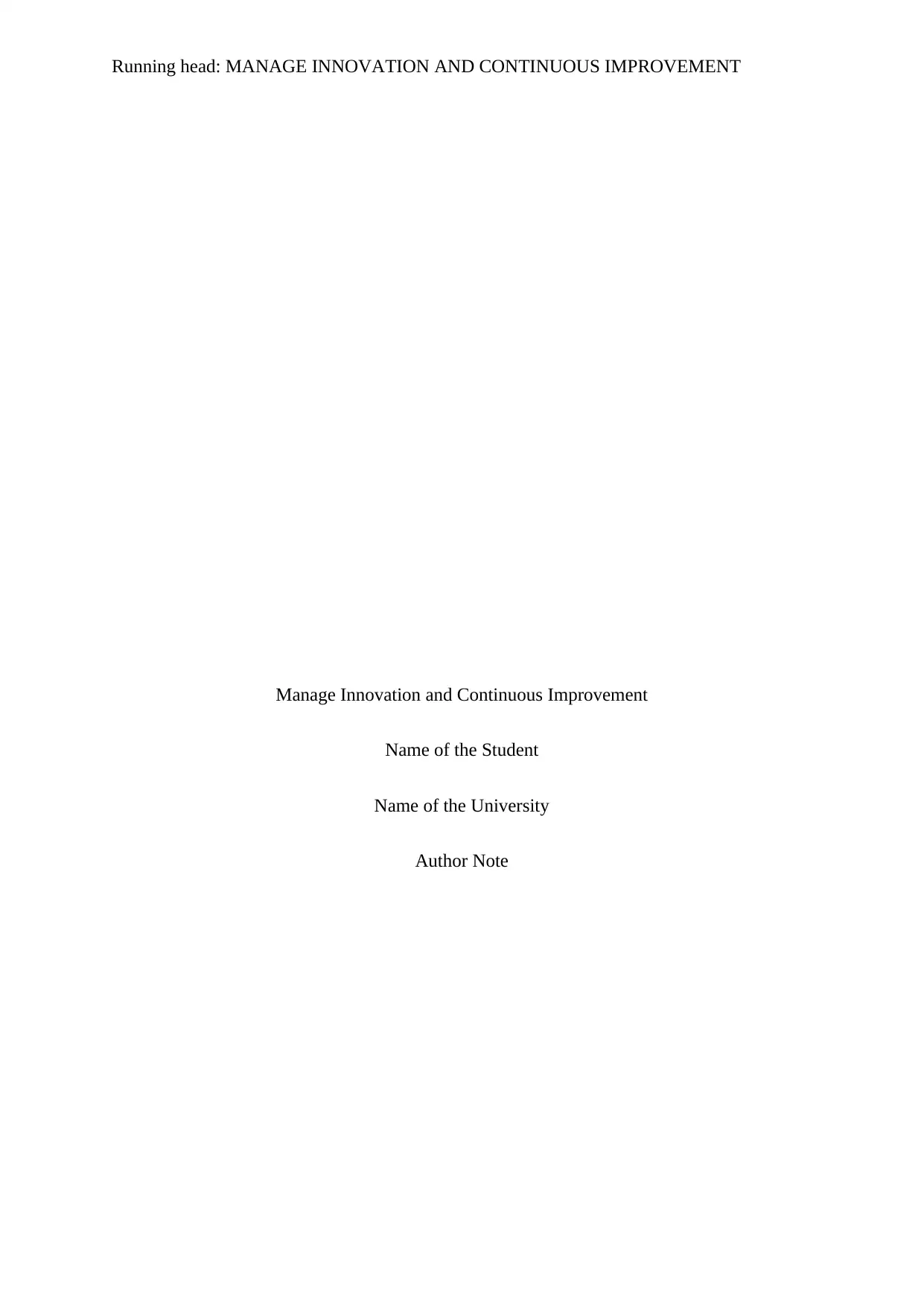
Running head: MANAGE INNOVATION AND CONTINUOUS IMPROVEMENT
Manage Innovation and Continuous Improvement
Name of the Student
Name of the University
Author Note
Manage Innovation and Continuous Improvement
Name of the Student
Name of the University
Author Note
Secure Best Marks with AI Grader
Need help grading? Try our AI Grader for instant feedback on your assignments.
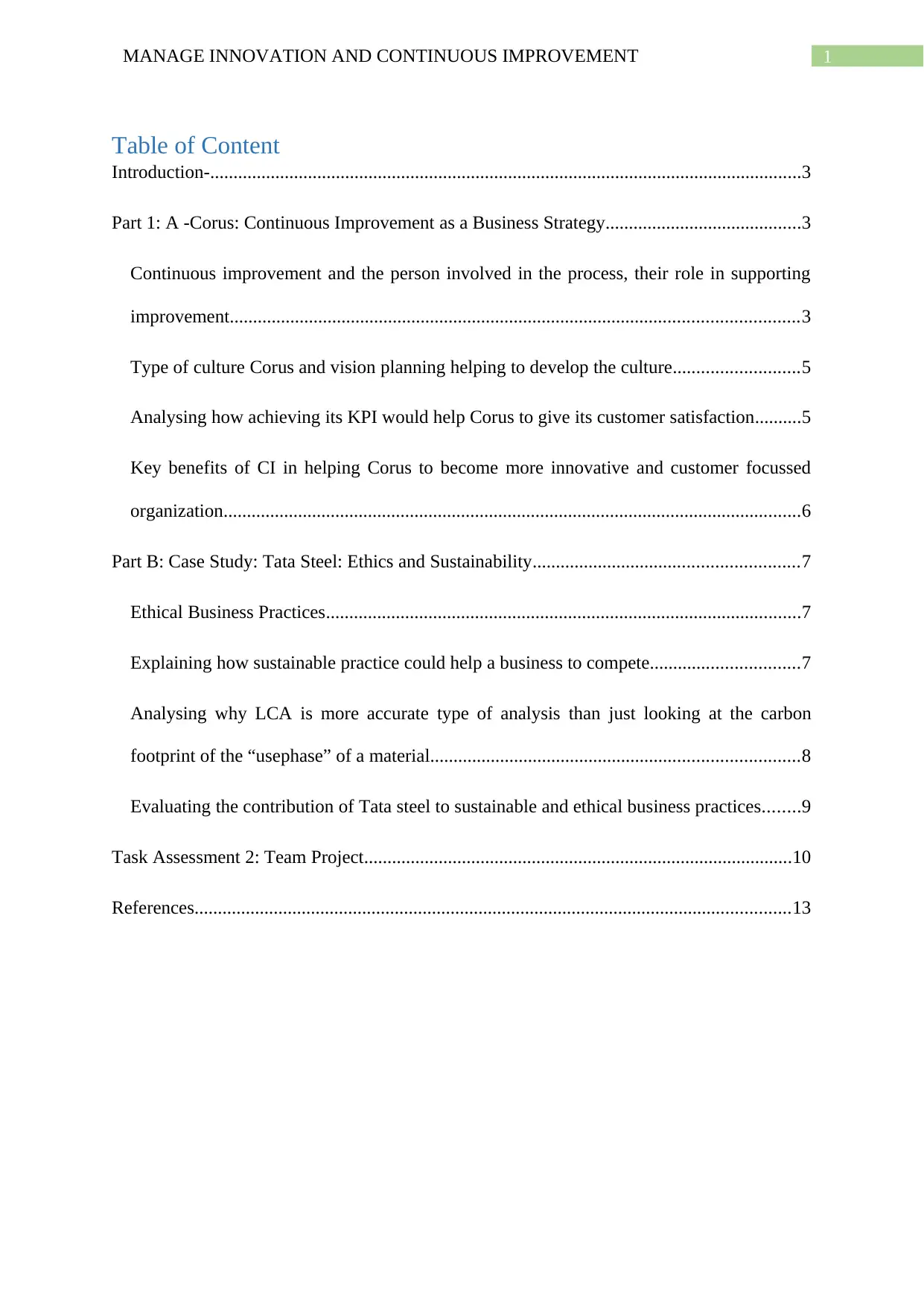
1MANAGE INNOVATION AND CONTINUOUS IMPROVEMENT
Table of Content
Introduction-...............................................................................................................................3
Part 1: A -Corus: Continuous Improvement as a Business Strategy..........................................3
Continuous improvement and the person involved in the process, their role in supporting
improvement..........................................................................................................................3
Type of culture Corus and vision planning helping to develop the culture...........................5
Analysing how achieving its KPI would help Corus to give its customer satisfaction..........5
Key benefits of CI in helping Corus to become more innovative and customer focussed
organization............................................................................................................................6
Part B: Case Study: Tata Steel: Ethics and Sustainability.........................................................7
Ethical Business Practices......................................................................................................7
Explaining how sustainable practice could help a business to compete................................7
Analysing why LCA is more accurate type of analysis than just looking at the carbon
footprint of the “usephase” of a material...............................................................................8
Evaluating the contribution of Tata steel to sustainable and ethical business practices........9
Task Assessment 2: Team Project............................................................................................10
References................................................................................................................................13
Table of Content
Introduction-...............................................................................................................................3
Part 1: A -Corus: Continuous Improvement as a Business Strategy..........................................3
Continuous improvement and the person involved in the process, their role in supporting
improvement..........................................................................................................................3
Type of culture Corus and vision planning helping to develop the culture...........................5
Analysing how achieving its KPI would help Corus to give its customer satisfaction..........5
Key benefits of CI in helping Corus to become more innovative and customer focussed
organization............................................................................................................................6
Part B: Case Study: Tata Steel: Ethics and Sustainability.........................................................7
Ethical Business Practices......................................................................................................7
Explaining how sustainable practice could help a business to compete................................7
Analysing why LCA is more accurate type of analysis than just looking at the carbon
footprint of the “usephase” of a material...............................................................................8
Evaluating the contribution of Tata steel to sustainable and ethical business practices........9
Task Assessment 2: Team Project............................................................................................10
References................................................................................................................................13
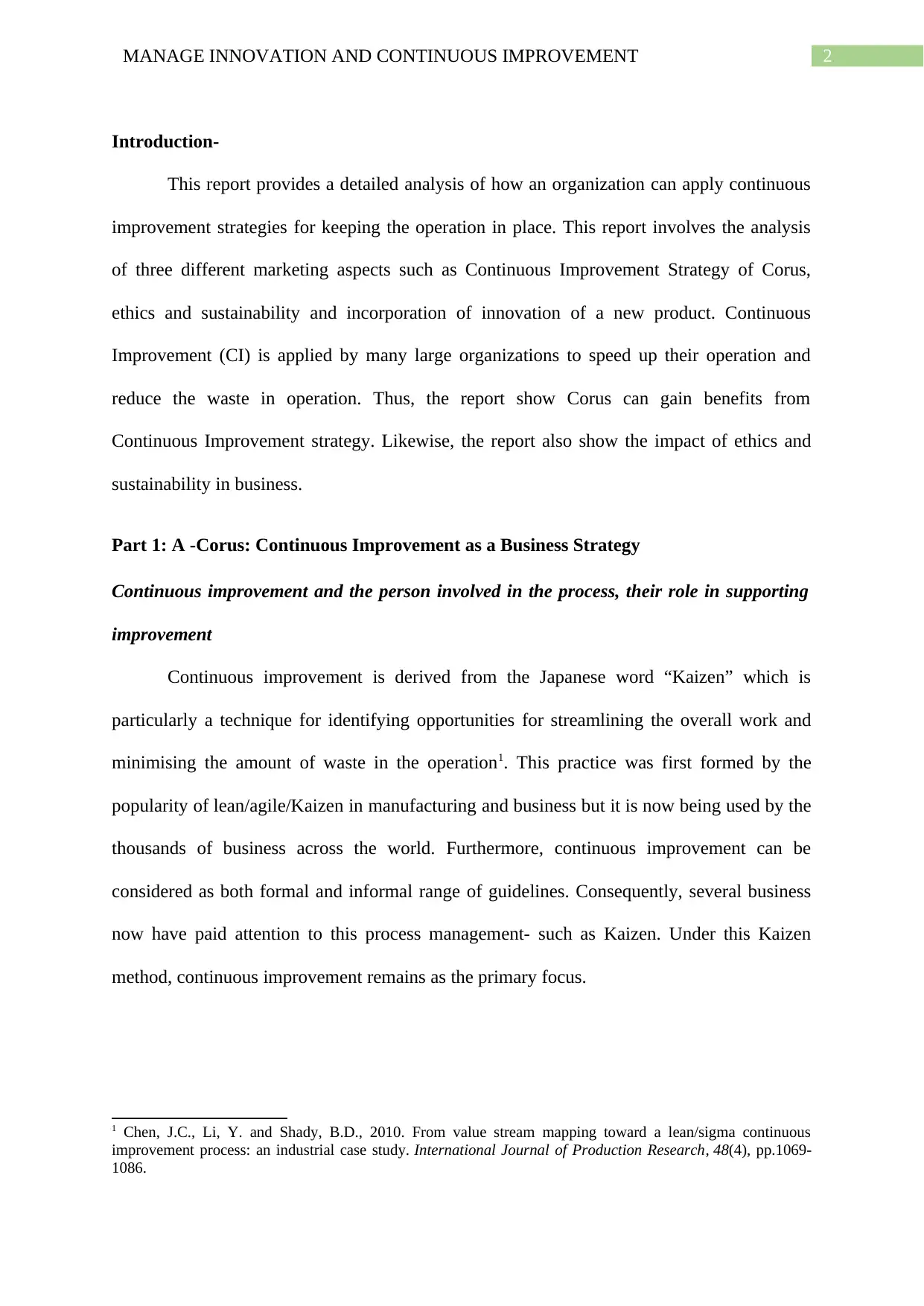
2MANAGE INNOVATION AND CONTINUOUS IMPROVEMENT
Introduction-
This report provides a detailed analysis of how an organization can apply continuous
improvement strategies for keeping the operation in place. This report involves the analysis
of three different marketing aspects such as Continuous Improvement Strategy of Corus,
ethics and sustainability and incorporation of innovation of a new product. Continuous
Improvement (CI) is applied by many large organizations to speed up their operation and
reduce the waste in operation. Thus, the report show Corus can gain benefits from
Continuous Improvement strategy. Likewise, the report also show the impact of ethics and
sustainability in business.
Part 1: A -Corus: Continuous Improvement as a Business Strategy
Continuous improvement and the person involved in the process, their role in supporting
improvement
Continuous improvement is derived from the Japanese word “Kaizen” which is
particularly a technique for identifying opportunities for streamlining the overall work and
minimising the amount of waste in the operation1. This practice was first formed by the
popularity of lean/agile/Kaizen in manufacturing and business but it is now being used by the
thousands of business across the world. Furthermore, continuous improvement can be
considered as both formal and informal range of guidelines. Consequently, several business
now have paid attention to this process management- such as Kaizen. Under this Kaizen
method, continuous improvement remains as the primary focus.
1 Chen, J.C., Li, Y. and Shady, B.D., 2010. From value stream mapping toward a lean/sigma continuous
improvement process: an industrial case study. International Journal of Production Research, 48(4), pp.1069-
1086.
Introduction-
This report provides a detailed analysis of how an organization can apply continuous
improvement strategies for keeping the operation in place. This report involves the analysis
of three different marketing aspects such as Continuous Improvement Strategy of Corus,
ethics and sustainability and incorporation of innovation of a new product. Continuous
Improvement (CI) is applied by many large organizations to speed up their operation and
reduce the waste in operation. Thus, the report show Corus can gain benefits from
Continuous Improvement strategy. Likewise, the report also show the impact of ethics and
sustainability in business.
Part 1: A -Corus: Continuous Improvement as a Business Strategy
Continuous improvement and the person involved in the process, their role in supporting
improvement
Continuous improvement is derived from the Japanese word “Kaizen” which is
particularly a technique for identifying opportunities for streamlining the overall work and
minimising the amount of waste in the operation1. This practice was first formed by the
popularity of lean/agile/Kaizen in manufacturing and business but it is now being used by the
thousands of business across the world. Furthermore, continuous improvement can be
considered as both formal and informal range of guidelines. Consequently, several business
now have paid attention to this process management- such as Kaizen. Under this Kaizen
method, continuous improvement remains as the primary focus.
1 Chen, J.C., Li, Y. and Shady, B.D., 2010. From value stream mapping toward a lean/sigma continuous
improvement process: an industrial case study. International Journal of Production Research, 48(4), pp.1069-
1086.
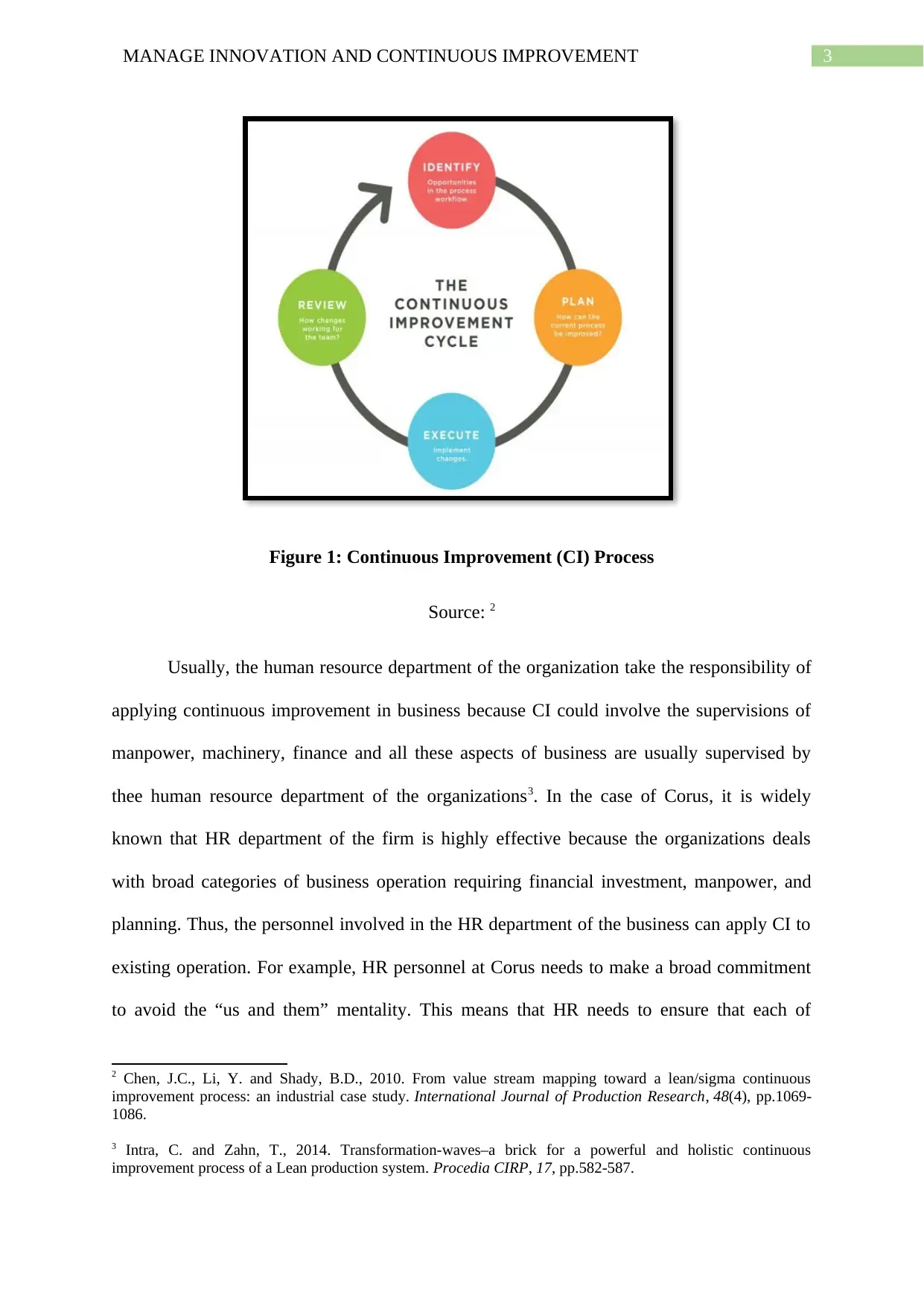
3MANAGE INNOVATION AND CONTINUOUS IMPROVEMENT
Figure 1: Continuous Improvement (CI) Process
Source: 2
Usually, the human resource department of the organization take the responsibility of
applying continuous improvement in business because CI could involve the supervisions of
manpower, machinery, finance and all these aspects of business are usually supervised by
thee human resource department of the organizations3. In the case of Corus, it is widely
known that HR department of the firm is highly effective because the organizations deals
with broad categories of business operation requiring financial investment, manpower, and
planning. Thus, the personnel involved in the HR department of the business can apply CI to
existing operation. For example, HR personnel at Corus needs to make a broad commitment
to avoid the “us and them” mentality. This means that HR needs to ensure that each of
2 Chen, J.C., Li, Y. and Shady, B.D., 2010. From value stream mapping toward a lean/sigma continuous
improvement process: an industrial case study. International Journal of Production Research, 48(4), pp.1069-
1086.
3 Intra, C. and Zahn, T., 2014. Transformation-waves–a brick for a powerful and holistic continuous
improvement process of a Lean production system. Procedia CIRP, 17, pp.582-587.
Figure 1: Continuous Improvement (CI) Process
Source: 2
Usually, the human resource department of the organization take the responsibility of
applying continuous improvement in business because CI could involve the supervisions of
manpower, machinery, finance and all these aspects of business are usually supervised by
thee human resource department of the organizations3. In the case of Corus, it is widely
known that HR department of the firm is highly effective because the organizations deals
with broad categories of business operation requiring financial investment, manpower, and
planning. Thus, the personnel involved in the HR department of the business can apply CI to
existing operation. For example, HR personnel at Corus needs to make a broad commitment
to avoid the “us and them” mentality. This means that HR needs to ensure that each of
2 Chen, J.C., Li, Y. and Shady, B.D., 2010. From value stream mapping toward a lean/sigma continuous
improvement process: an industrial case study. International Journal of Production Research, 48(4), pp.1069-
1086.
3 Intra, C. and Zahn, T., 2014. Transformation-waves–a brick for a powerful and holistic continuous
improvement process of a Lean production system. Procedia CIRP, 17, pp.582-587.
Secure Best Marks with AI Grader
Need help grading? Try our AI Grader for instant feedback on your assignments.
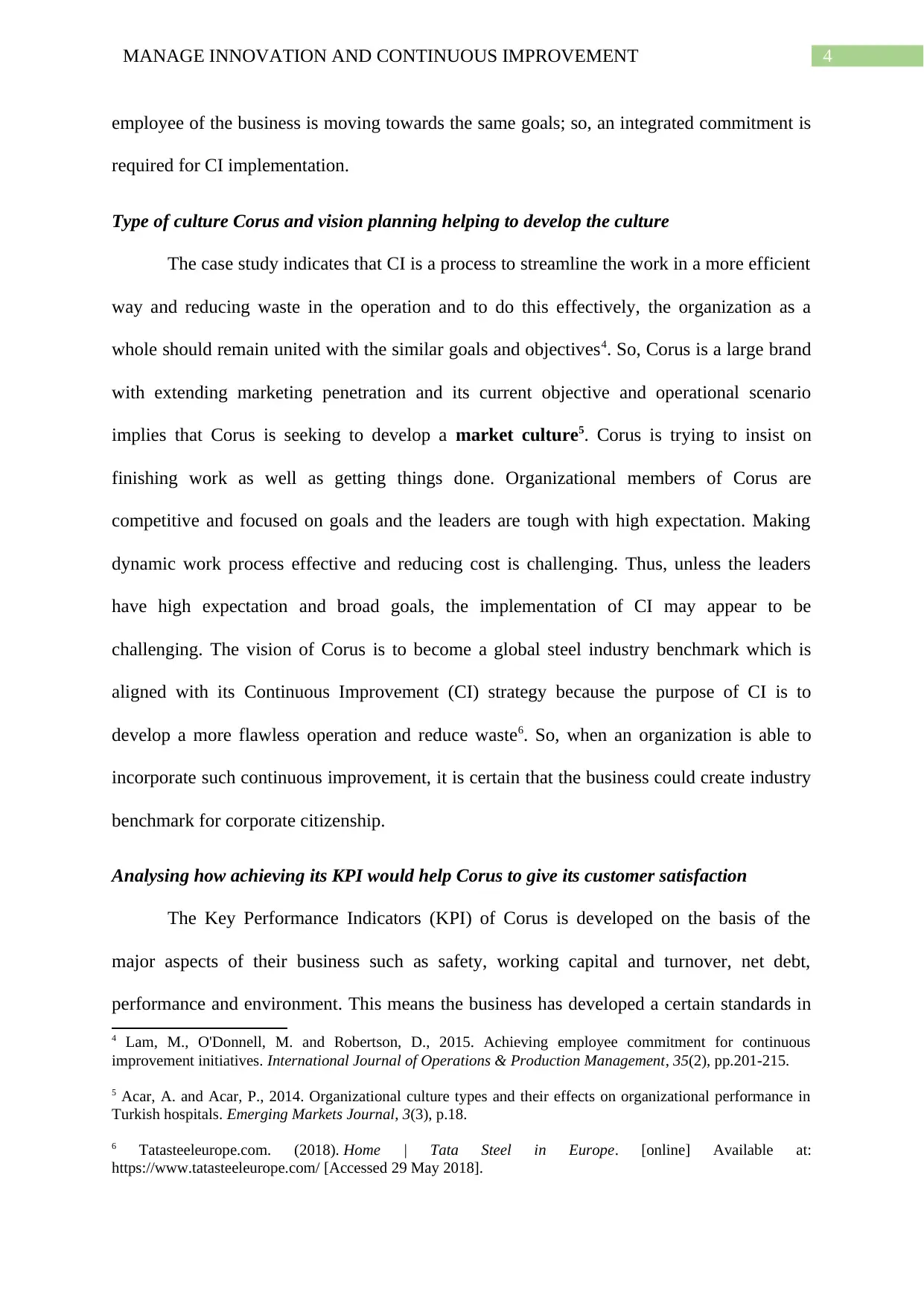
4MANAGE INNOVATION AND CONTINUOUS IMPROVEMENT
employee of the business is moving towards the same goals; so, an integrated commitment is
required for CI implementation.
Type of culture Corus and vision planning helping to develop the culture
The case study indicates that CI is a process to streamline the work in a more efficient
way and reducing waste in the operation and to do this effectively, the organization as a
whole should remain united with the similar goals and objectives4. So, Corus is a large brand
with extending marketing penetration and its current objective and operational scenario
implies that Corus is seeking to develop a market culture5. Corus is trying to insist on
finishing work as well as getting things done. Organizational members of Corus are
competitive and focused on goals and the leaders are tough with high expectation. Making
dynamic work process effective and reducing cost is challenging. Thus, unless the leaders
have high expectation and broad goals, the implementation of CI may appear to be
challenging. The vision of Corus is to become a global steel industry benchmark which is
aligned with its Continuous Improvement (CI) strategy because the purpose of CI is to
develop a more flawless operation and reduce waste6. So, when an organization is able to
incorporate such continuous improvement, it is certain that the business could create industry
benchmark for corporate citizenship.
Analysing how achieving its KPI would help Corus to give its customer satisfaction
The Key Performance Indicators (KPI) of Corus is developed on the basis of the
major aspects of their business such as safety, working capital and turnover, net debt,
performance and environment. This means the business has developed a certain standards in
4 Lam, M., O'Donnell, M. and Robertson, D., 2015. Achieving employee commitment for continuous
improvement initiatives. International Journal of Operations & Production Management, 35(2), pp.201-215.
5 Acar, A. and Acar, P., 2014. Organizational culture types and their effects on organizational performance in
Turkish hospitals. Emerging Markets Journal, 3(3), p.18.
6 Tatasteeleurope.com. (2018). Home | Tata Steel in Europe. [online] Available at:
https://www.tatasteeleurope.com/ [Accessed 29 May 2018].
employee of the business is moving towards the same goals; so, an integrated commitment is
required for CI implementation.
Type of culture Corus and vision planning helping to develop the culture
The case study indicates that CI is a process to streamline the work in a more efficient
way and reducing waste in the operation and to do this effectively, the organization as a
whole should remain united with the similar goals and objectives4. So, Corus is a large brand
with extending marketing penetration and its current objective and operational scenario
implies that Corus is seeking to develop a market culture5. Corus is trying to insist on
finishing work as well as getting things done. Organizational members of Corus are
competitive and focused on goals and the leaders are tough with high expectation. Making
dynamic work process effective and reducing cost is challenging. Thus, unless the leaders
have high expectation and broad goals, the implementation of CI may appear to be
challenging. The vision of Corus is to become a global steel industry benchmark which is
aligned with its Continuous Improvement (CI) strategy because the purpose of CI is to
develop a more flawless operation and reduce waste6. So, when an organization is able to
incorporate such continuous improvement, it is certain that the business could create industry
benchmark for corporate citizenship.
Analysing how achieving its KPI would help Corus to give its customer satisfaction
The Key Performance Indicators (KPI) of Corus is developed on the basis of the
major aspects of their business such as safety, working capital and turnover, net debt,
performance and environment. This means the business has developed a certain standards in
4 Lam, M., O'Donnell, M. and Robertson, D., 2015. Achieving employee commitment for continuous
improvement initiatives. International Journal of Operations & Production Management, 35(2), pp.201-215.
5 Acar, A. and Acar, P., 2014. Organizational culture types and their effects on organizational performance in
Turkish hospitals. Emerging Markets Journal, 3(3), p.18.
6 Tatasteeleurope.com. (2018). Home | Tata Steel in Europe. [online] Available at:
https://www.tatasteeleurope.com/ [Accessed 29 May 2018].
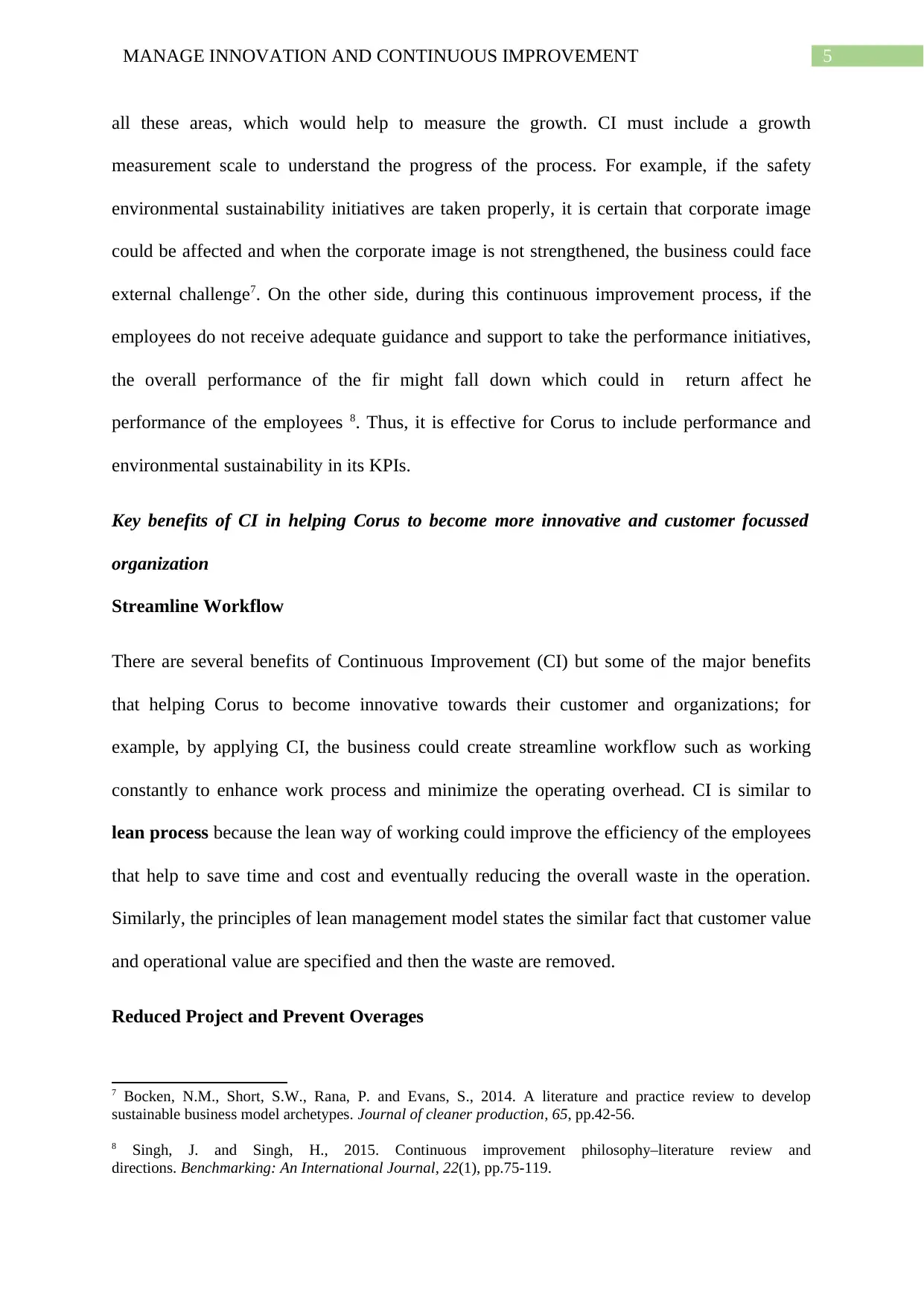
5MANAGE INNOVATION AND CONTINUOUS IMPROVEMENT
all these areas, which would help to measure the growth. CI must include a growth
measurement scale to understand the progress of the process. For example, if the safety
environmental sustainability initiatives are taken properly, it is certain that corporate image
could be affected and when the corporate image is not strengthened, the business could face
external challenge7. On the other side, during this continuous improvement process, if the
employees do not receive adequate guidance and support to take the performance initiatives,
the overall performance of the fir might fall down which could in return affect he
performance of the employees 8. Thus, it is effective for Corus to include performance and
environmental sustainability in its KPIs.
Key benefits of CI in helping Corus to become more innovative and customer focussed
organization
Streamline Workflow
There are several benefits of Continuous Improvement (CI) but some of the major benefits
that helping Corus to become innovative towards their customer and organizations; for
example, by applying CI, the business could create streamline workflow such as working
constantly to enhance work process and minimize the operating overhead. CI is similar to
lean process because the lean way of working could improve the efficiency of the employees
that help to save time and cost and eventually reducing the overall waste in the operation.
Similarly, the principles of lean management model states the similar fact that customer value
and operational value are specified and then the waste are removed.
Reduced Project and Prevent Overages
7 Bocken, N.M., Short, S.W., Rana, P. and Evans, S., 2014. A literature and practice review to develop
sustainable business model archetypes. Journal of cleaner production, 65, pp.42-56.
8 Singh, J. and Singh, H., 2015. Continuous improvement philosophy–literature review and
directions. Benchmarking: An International Journal, 22(1), pp.75-119.
all these areas, which would help to measure the growth. CI must include a growth
measurement scale to understand the progress of the process. For example, if the safety
environmental sustainability initiatives are taken properly, it is certain that corporate image
could be affected and when the corporate image is not strengthened, the business could face
external challenge7. On the other side, during this continuous improvement process, if the
employees do not receive adequate guidance and support to take the performance initiatives,
the overall performance of the fir might fall down which could in return affect he
performance of the employees 8. Thus, it is effective for Corus to include performance and
environmental sustainability in its KPIs.
Key benefits of CI in helping Corus to become more innovative and customer focussed
organization
Streamline Workflow
There are several benefits of Continuous Improvement (CI) but some of the major benefits
that helping Corus to become innovative towards their customer and organizations; for
example, by applying CI, the business could create streamline workflow such as working
constantly to enhance work process and minimize the operating overhead. CI is similar to
lean process because the lean way of working could improve the efficiency of the employees
that help to save time and cost and eventually reducing the overall waste in the operation.
Similarly, the principles of lean management model states the similar fact that customer value
and operational value are specified and then the waste are removed.
Reduced Project and Prevent Overages
7 Bocken, N.M., Short, S.W., Rana, P. and Evans, S., 2014. A literature and practice review to develop
sustainable business model archetypes. Journal of cleaner production, 65, pp.42-56.
8 Singh, J. and Singh, H., 2015. Continuous improvement philosophy–literature review and
directions. Benchmarking: An International Journal, 22(1), pp.75-119.
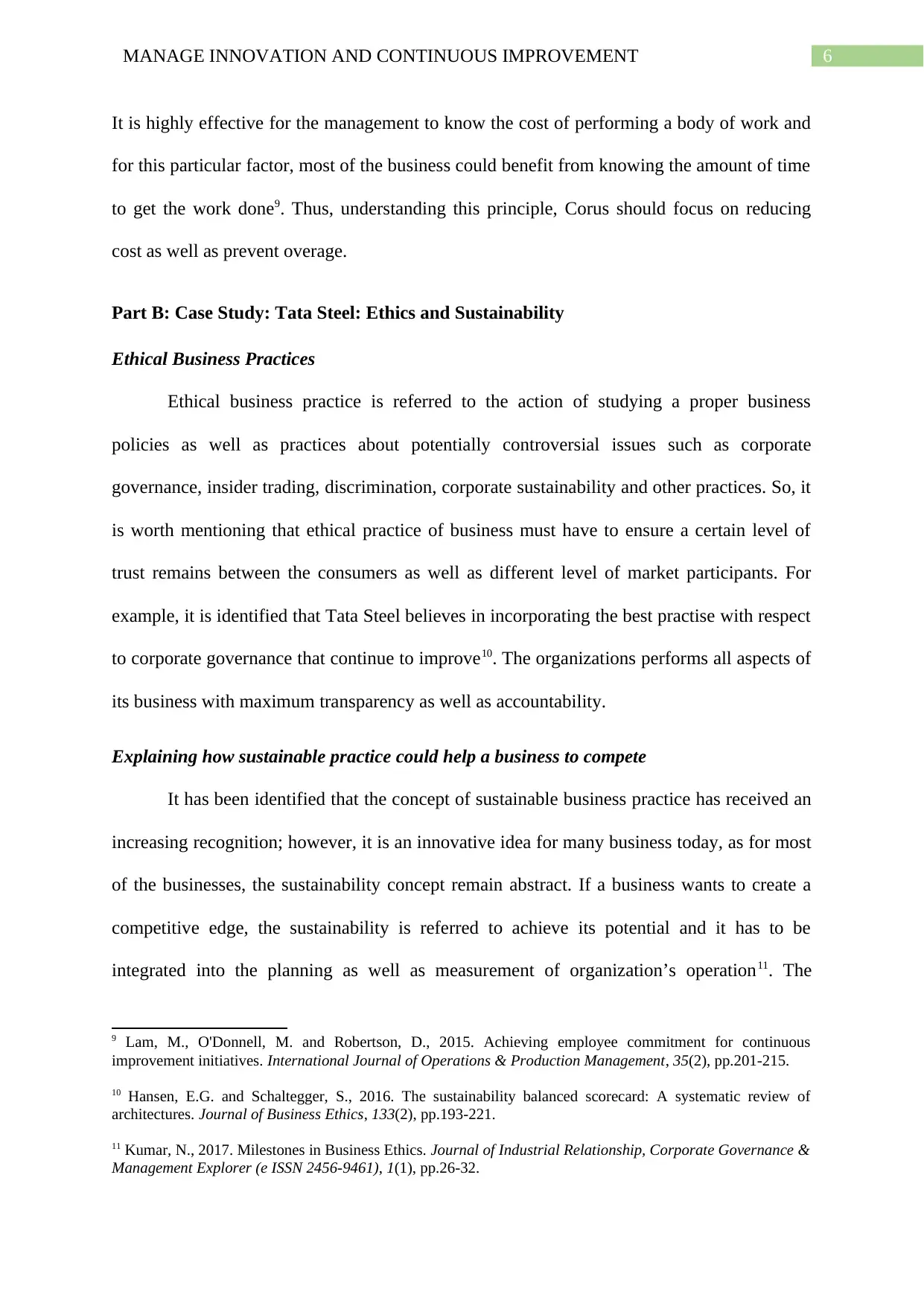
6MANAGE INNOVATION AND CONTINUOUS IMPROVEMENT
It is highly effective for the management to know the cost of performing a body of work and
for this particular factor, most of the business could benefit from knowing the amount of time
to get the work done9. Thus, understanding this principle, Corus should focus on reducing
cost as well as prevent overage.
Part B: Case Study: Tata Steel: Ethics and Sustainability
Ethical Business Practices
Ethical business practice is referred to the action of studying a proper business
policies as well as practices about potentially controversial issues such as corporate
governance, insider trading, discrimination, corporate sustainability and other practices. So, it
is worth mentioning that ethical practice of business must have to ensure a certain level of
trust remains between the consumers as well as different level of market participants. For
example, it is identified that Tata Steel believes in incorporating the best practise with respect
to corporate governance that continue to improve10. The organizations performs all aspects of
its business with maximum transparency as well as accountability.
Explaining how sustainable practice could help a business to compete
It has been identified that the concept of sustainable business practice has received an
increasing recognition; however, it is an innovative idea for many business today, as for most
of the businesses, the sustainability concept remain abstract. If a business wants to create a
competitive edge, the sustainability is referred to achieve its potential and it has to be
integrated into the planning as well as measurement of organization’s operation11. The
9 Lam, M., O'Donnell, M. and Robertson, D., 2015. Achieving employee commitment for continuous
improvement initiatives. International Journal of Operations & Production Management, 35(2), pp.201-215.
10 Hansen, E.G. and Schaltegger, S., 2016. The sustainability balanced scorecard: A systematic review of
architectures. Journal of Business Ethics, 133(2), pp.193-221.
11 Kumar, N., 2017. Milestones in Business Ethics. Journal of Industrial Relationship, Corporate Governance &
Management Explorer (e ISSN 2456-9461), 1(1), pp.26-32.
It is highly effective for the management to know the cost of performing a body of work and
for this particular factor, most of the business could benefit from knowing the amount of time
to get the work done9. Thus, understanding this principle, Corus should focus on reducing
cost as well as prevent overage.
Part B: Case Study: Tata Steel: Ethics and Sustainability
Ethical Business Practices
Ethical business practice is referred to the action of studying a proper business
policies as well as practices about potentially controversial issues such as corporate
governance, insider trading, discrimination, corporate sustainability and other practices. So, it
is worth mentioning that ethical practice of business must have to ensure a certain level of
trust remains between the consumers as well as different level of market participants. For
example, it is identified that Tata Steel believes in incorporating the best practise with respect
to corporate governance that continue to improve10. The organizations performs all aspects of
its business with maximum transparency as well as accountability.
Explaining how sustainable practice could help a business to compete
It has been identified that the concept of sustainable business practice has received an
increasing recognition; however, it is an innovative idea for many business today, as for most
of the businesses, the sustainability concept remain abstract. If a business wants to create a
competitive edge, the sustainability is referred to achieve its potential and it has to be
integrated into the planning as well as measurement of organization’s operation11. The
9 Lam, M., O'Donnell, M. and Robertson, D., 2015. Achieving employee commitment for continuous
improvement initiatives. International Journal of Operations & Production Management, 35(2), pp.201-215.
10 Hansen, E.G. and Schaltegger, S., 2016. The sustainability balanced scorecard: A systematic review of
architectures. Journal of Business Ethics, 133(2), pp.193-221.
11 Kumar, N., 2017. Milestones in Business Ethics. Journal of Industrial Relationship, Corporate Governance &
Management Explorer (e ISSN 2456-9461), 1(1), pp.26-32.
Paraphrase This Document
Need a fresh take? Get an instant paraphrase of this document with our AI Paraphraser
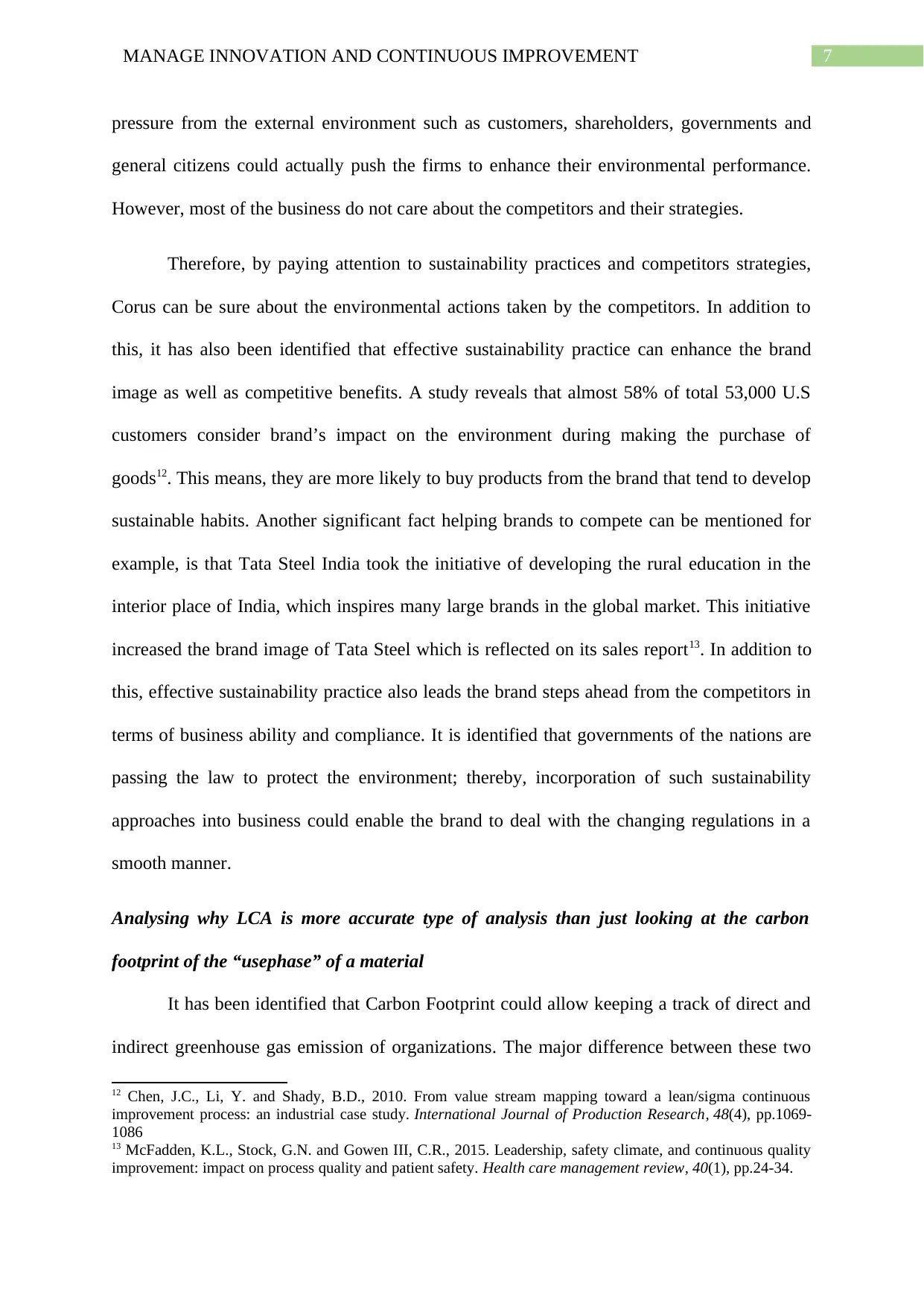
7MANAGE INNOVATION AND CONTINUOUS IMPROVEMENT
pressure from the external environment such as customers, shareholders, governments and
general citizens could actually push the firms to enhance their environmental performance.
However, most of the business do not care about the competitors and their strategies.
Therefore, by paying attention to sustainability practices and competitors strategies,
Corus can be sure about the environmental actions taken by the competitors. In addition to
this, it has also been identified that effective sustainability practice can enhance the brand
image as well as competitive benefits. A study reveals that almost 58% of total 53,000 U.S
customers consider brand’s impact on the environment during making the purchase of
goods12. This means, they are more likely to buy products from the brand that tend to develop
sustainable habits. Another significant fact helping brands to compete can be mentioned for
example, is that Tata Steel India took the initiative of developing the rural education in the
interior place of India, which inspires many large brands in the global market. This initiative
increased the brand image of Tata Steel which is reflected on its sales report13. In addition to
this, effective sustainability practice also leads the brand steps ahead from the competitors in
terms of business ability and compliance. It is identified that governments of the nations are
passing the law to protect the environment; thereby, incorporation of such sustainability
approaches into business could enable the brand to deal with the changing regulations in a
smooth manner.
Analysing why LCA is more accurate type of analysis than just looking at the carbon
footprint of the “usephase” of a material
It has been identified that Carbon Footprint could allow keeping a track of direct and
indirect greenhouse gas emission of organizations. The major difference between these two
12 Chen, J.C., Li, Y. and Shady, B.D., 2010. From value stream mapping toward a lean/sigma continuous
improvement process: an industrial case study. International Journal of Production Research, 48(4), pp.1069-
1086
13 McFadden, K.L., Stock, G.N. and Gowen III, C.R., 2015. Leadership, safety climate, and continuous quality
improvement: impact on process quality and patient safety. Health care management review, 40(1), pp.24-34.
pressure from the external environment such as customers, shareholders, governments and
general citizens could actually push the firms to enhance their environmental performance.
However, most of the business do not care about the competitors and their strategies.
Therefore, by paying attention to sustainability practices and competitors strategies,
Corus can be sure about the environmental actions taken by the competitors. In addition to
this, it has also been identified that effective sustainability practice can enhance the brand
image as well as competitive benefits. A study reveals that almost 58% of total 53,000 U.S
customers consider brand’s impact on the environment during making the purchase of
goods12. This means, they are more likely to buy products from the brand that tend to develop
sustainable habits. Another significant fact helping brands to compete can be mentioned for
example, is that Tata Steel India took the initiative of developing the rural education in the
interior place of India, which inspires many large brands in the global market. This initiative
increased the brand image of Tata Steel which is reflected on its sales report13. In addition to
this, effective sustainability practice also leads the brand steps ahead from the competitors in
terms of business ability and compliance. It is identified that governments of the nations are
passing the law to protect the environment; thereby, incorporation of such sustainability
approaches into business could enable the brand to deal with the changing regulations in a
smooth manner.
Analysing why LCA is more accurate type of analysis than just looking at the carbon
footprint of the “usephase” of a material
It has been identified that Carbon Footprint could allow keeping a track of direct and
indirect greenhouse gas emission of organizations. The major difference between these two
12 Chen, J.C., Li, Y. and Shady, B.D., 2010. From value stream mapping toward a lean/sigma continuous
improvement process: an industrial case study. International Journal of Production Research, 48(4), pp.1069-
1086
13 McFadden, K.L., Stock, G.N. and Gowen III, C.R., 2015. Leadership, safety climate, and continuous quality
improvement: impact on process quality and patient safety. Health care management review, 40(1), pp.24-34.
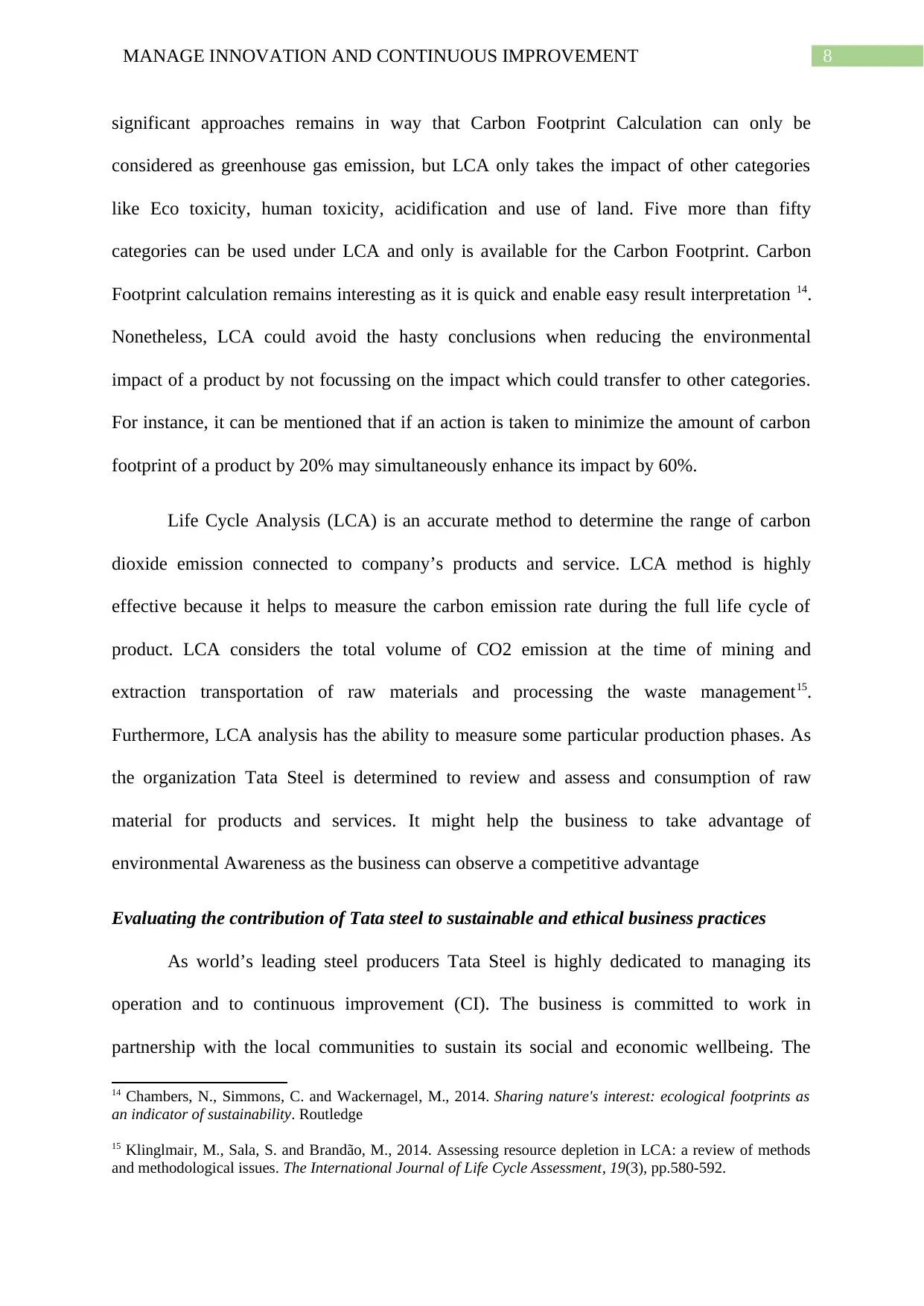
8MANAGE INNOVATION AND CONTINUOUS IMPROVEMENT
significant approaches remains in way that Carbon Footprint Calculation can only be
considered as greenhouse gas emission, but LCA only takes the impact of other categories
like Eco toxicity, human toxicity, acidification and use of land. Five more than fifty
categories can be used under LCA and only is available for the Carbon Footprint. Carbon
Footprint calculation remains interesting as it is quick and enable easy result interpretation 14.
Nonetheless, LCA could avoid the hasty conclusions when reducing the environmental
impact of a product by not focussing on the impact which could transfer to other categories.
For instance, it can be mentioned that if an action is taken to minimize the amount of carbon
footprint of a product by 20% may simultaneously enhance its impact by 60%.
Life Cycle Analysis (LCA) is an accurate method to determine the range of carbon
dioxide emission connected to company’s products and service. LCA method is highly
effective because it helps to measure the carbon emission rate during the full life cycle of
product. LCA considers the total volume of CO2 emission at the time of mining and
extraction transportation of raw materials and processing the waste management15.
Furthermore, LCA analysis has the ability to measure some particular production phases. As
the organization Tata Steel is determined to review and assess and consumption of raw
material for products and services. It might help the business to take advantage of
environmental Awareness as the business can observe a competitive advantage
Evaluating the contribution of Tata steel to sustainable and ethical business practices
As world’s leading steel producers Tata Steel is highly dedicated to managing its
operation and to continuous improvement (CI). The business is committed to work in
partnership with the local communities to sustain its social and economic wellbeing. The
14 Chambers, N., Simmons, C. and Wackernagel, M., 2014. Sharing nature's interest: ecological footprints as
an indicator of sustainability. Routledge
15 Klinglmair, M., Sala, S. and Brandão, M., 2014. Assessing resource depletion in LCA: a review of methods
and methodological issues. The International Journal of Life Cycle Assessment, 19(3), pp.580-592.
significant approaches remains in way that Carbon Footprint Calculation can only be
considered as greenhouse gas emission, but LCA only takes the impact of other categories
like Eco toxicity, human toxicity, acidification and use of land. Five more than fifty
categories can be used under LCA and only is available for the Carbon Footprint. Carbon
Footprint calculation remains interesting as it is quick and enable easy result interpretation 14.
Nonetheless, LCA could avoid the hasty conclusions when reducing the environmental
impact of a product by not focussing on the impact which could transfer to other categories.
For instance, it can be mentioned that if an action is taken to minimize the amount of carbon
footprint of a product by 20% may simultaneously enhance its impact by 60%.
Life Cycle Analysis (LCA) is an accurate method to determine the range of carbon
dioxide emission connected to company’s products and service. LCA method is highly
effective because it helps to measure the carbon emission rate during the full life cycle of
product. LCA considers the total volume of CO2 emission at the time of mining and
extraction transportation of raw materials and processing the waste management15.
Furthermore, LCA analysis has the ability to measure some particular production phases. As
the organization Tata Steel is determined to review and assess and consumption of raw
material for products and services. It might help the business to take advantage of
environmental Awareness as the business can observe a competitive advantage
Evaluating the contribution of Tata steel to sustainable and ethical business practices
As world’s leading steel producers Tata Steel is highly dedicated to managing its
operation and to continuous improvement (CI). The business is committed to work in
partnership with the local communities to sustain its social and economic wellbeing. The
14 Chambers, N., Simmons, C. and Wackernagel, M., 2014. Sharing nature's interest: ecological footprints as
an indicator of sustainability. Routledge
15 Klinglmair, M., Sala, S. and Brandão, M., 2014. Assessing resource depletion in LCA: a review of methods
and methodological issues. The International Journal of Life Cycle Assessment, 19(3), pp.580-592.
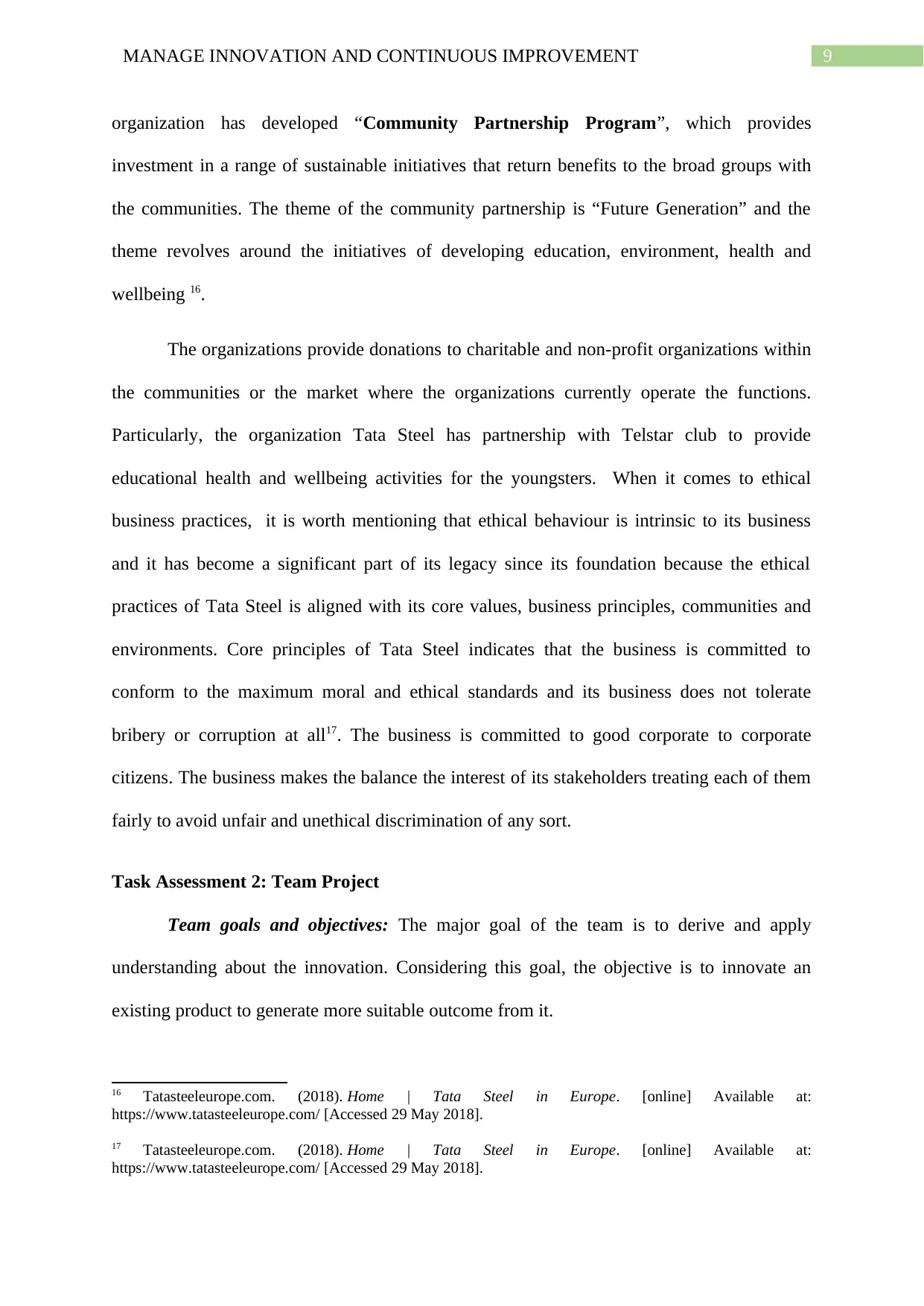
9MANAGE INNOVATION AND CONTINUOUS IMPROVEMENT
organization has developed “Community Partnership Program”, which provides
investment in a range of sustainable initiatives that return benefits to the broad groups with
the communities. The theme of the community partnership is “Future Generation” and the
theme revolves around the initiatives of developing education, environment, health and
wellbeing 16.
The organizations provide donations to charitable and non-profit organizations within
the communities or the market where the organizations currently operate the functions.
Particularly, the organization Tata Steel has partnership with Telstar club to provide
educational health and wellbeing activities for the youngsters. When it comes to ethical
business practices, it is worth mentioning that ethical behaviour is intrinsic to its business
and it has become a significant part of its legacy since its foundation because the ethical
practices of Tata Steel is aligned with its core values, business principles, communities and
environments. Core principles of Tata Steel indicates that the business is committed to
conform to the maximum moral and ethical standards and its business does not tolerate
bribery or corruption at all17. The business is committed to good corporate to corporate
citizens. The business makes the balance the interest of its stakeholders treating each of them
fairly to avoid unfair and unethical discrimination of any sort.
Task Assessment 2: Team Project
Team goals and objectives: The major goal of the team is to derive and apply
understanding about the innovation. Considering this goal, the objective is to innovate an
existing product to generate more suitable outcome from it.
16 Tatasteeleurope.com. (2018). Home | Tata Steel in Europe. [online] Available at:
https://www.tatasteeleurope.com/ [Accessed 29 May 2018].
17 Tatasteeleurope.com. (2018). Home | Tata Steel in Europe. [online] Available at:
https://www.tatasteeleurope.com/ [Accessed 29 May 2018].
organization has developed “Community Partnership Program”, which provides
investment in a range of sustainable initiatives that return benefits to the broad groups with
the communities. The theme of the community partnership is “Future Generation” and the
theme revolves around the initiatives of developing education, environment, health and
wellbeing 16.
The organizations provide donations to charitable and non-profit organizations within
the communities or the market where the organizations currently operate the functions.
Particularly, the organization Tata Steel has partnership with Telstar club to provide
educational health and wellbeing activities for the youngsters. When it comes to ethical
business practices, it is worth mentioning that ethical behaviour is intrinsic to its business
and it has become a significant part of its legacy since its foundation because the ethical
practices of Tata Steel is aligned with its core values, business principles, communities and
environments. Core principles of Tata Steel indicates that the business is committed to
conform to the maximum moral and ethical standards and its business does not tolerate
bribery or corruption at all17. The business is committed to good corporate to corporate
citizens. The business makes the balance the interest of its stakeholders treating each of them
fairly to avoid unfair and unethical discrimination of any sort.
Task Assessment 2: Team Project
Team goals and objectives: The major goal of the team is to derive and apply
understanding about the innovation. Considering this goal, the objective is to innovate an
existing product to generate more suitable outcome from it.
16 Tatasteeleurope.com. (2018). Home | Tata Steel in Europe. [online] Available at:
https://www.tatasteeleurope.com/ [Accessed 29 May 2018].
17 Tatasteeleurope.com. (2018). Home | Tata Steel in Europe. [online] Available at:
https://www.tatasteeleurope.com/ [Accessed 29 May 2018].
Secure Best Marks with AI Grader
Need help grading? Try our AI Grader for instant feedback on your assignments.
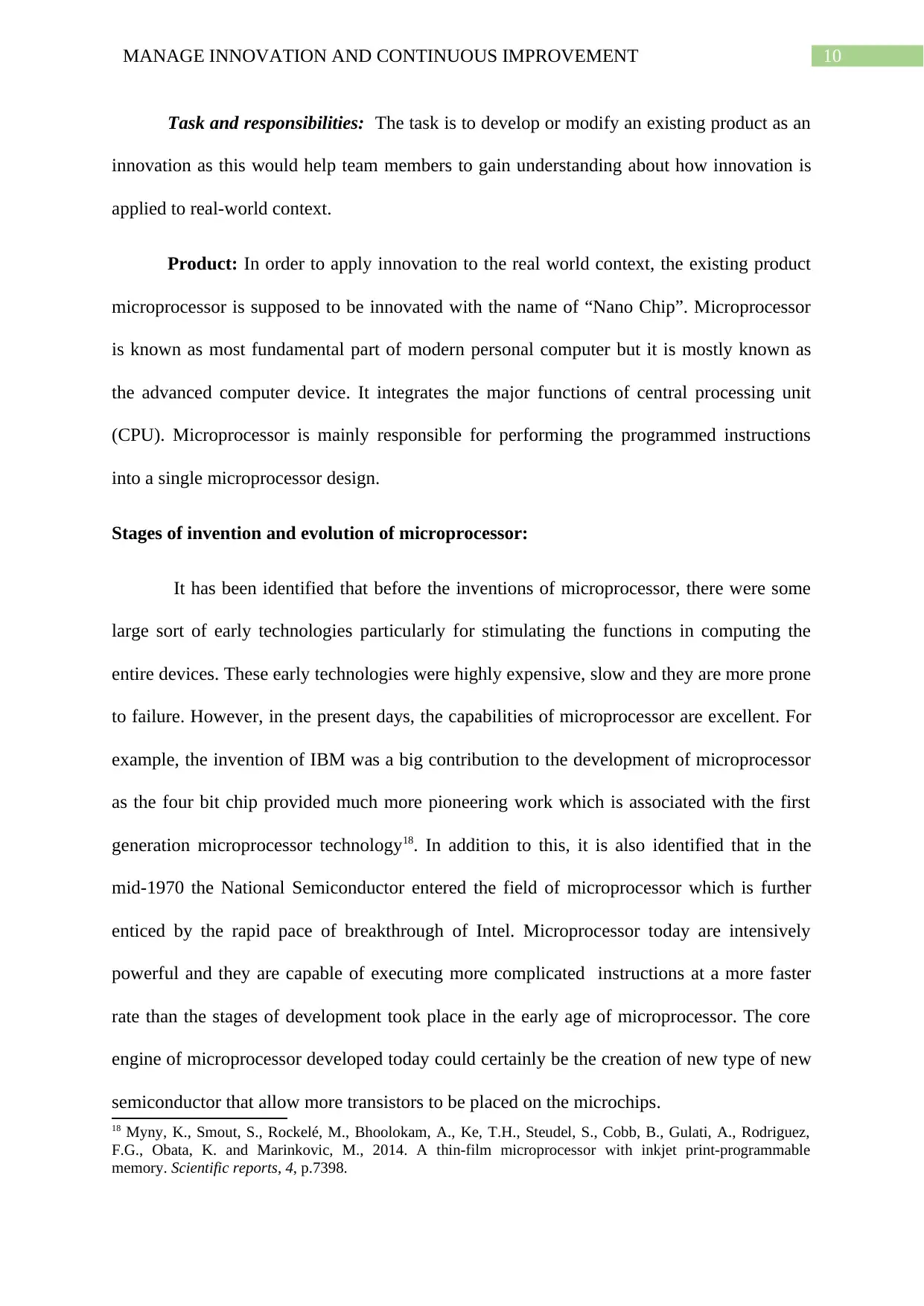
10MANAGE INNOVATION AND CONTINUOUS IMPROVEMENT
Task and responsibilities: The task is to develop or modify an existing product as an
innovation as this would help team members to gain understanding about how innovation is
applied to real-world context.
Product: In order to apply innovation to the real world context, the existing product
microprocessor is supposed to be innovated with the name of “Nano Chip”. Microprocessor
is known as most fundamental part of modern personal computer but it is mostly known as
the advanced computer device. It integrates the major functions of central processing unit
(CPU). Microprocessor is mainly responsible for performing the programmed instructions
into a single microprocessor design.
Stages of invention and evolution of microprocessor:
It has been identified that before the inventions of microprocessor, there were some
large sort of early technologies particularly for stimulating the functions in computing the
entire devices. These early technologies were highly expensive, slow and they are more prone
to failure. However, in the present days, the capabilities of microprocessor are excellent. For
example, the invention of IBM was a big contribution to the development of microprocessor
as the four bit chip provided much more pioneering work which is associated with the first
generation microprocessor technology18. In addition to this, it is also identified that in the
mid-1970 the National Semiconductor entered the field of microprocessor which is further
enticed by the rapid pace of breakthrough of Intel. Microprocessor today are intensively
powerful and they are capable of executing more complicated instructions at a more faster
rate than the stages of development took place in the early age of microprocessor. The core
engine of microprocessor developed today could certainly be the creation of new type of new
semiconductor that allow more transistors to be placed on the microchips.
18 Myny, K., Smout, S., Rockelé, M., Bhoolokam, A., Ke, T.H., Steudel, S., Cobb, B., Gulati, A., Rodriguez,
F.G., Obata, K. and Marinkovic, M., 2014. A thin-film microprocessor with inkjet print-programmable
memory. Scientific reports, 4, p.7398.
Task and responsibilities: The task is to develop or modify an existing product as an
innovation as this would help team members to gain understanding about how innovation is
applied to real-world context.
Product: In order to apply innovation to the real world context, the existing product
microprocessor is supposed to be innovated with the name of “Nano Chip”. Microprocessor
is known as most fundamental part of modern personal computer but it is mostly known as
the advanced computer device. It integrates the major functions of central processing unit
(CPU). Microprocessor is mainly responsible for performing the programmed instructions
into a single microprocessor design.
Stages of invention and evolution of microprocessor:
It has been identified that before the inventions of microprocessor, there were some
large sort of early technologies particularly for stimulating the functions in computing the
entire devices. These early technologies were highly expensive, slow and they are more prone
to failure. However, in the present days, the capabilities of microprocessor are excellent. For
example, the invention of IBM was a big contribution to the development of microprocessor
as the four bit chip provided much more pioneering work which is associated with the first
generation microprocessor technology18. In addition to this, it is also identified that in the
mid-1970 the National Semiconductor entered the field of microprocessor which is further
enticed by the rapid pace of breakthrough of Intel. Microprocessor today are intensively
powerful and they are capable of executing more complicated instructions at a more faster
rate than the stages of development took place in the early age of microprocessor. The core
engine of microprocessor developed today could certainly be the creation of new type of new
semiconductor that allow more transistors to be placed on the microchips.
18 Myny, K., Smout, S., Rockelé, M., Bhoolokam, A., Ke, T.H., Steudel, S., Cobb, B., Gulati, A., Rodriguez,
F.G., Obata, K. and Marinkovic, M., 2014. A thin-film microprocessor with inkjet print-programmable
memory. Scientific reports, 4, p.7398.
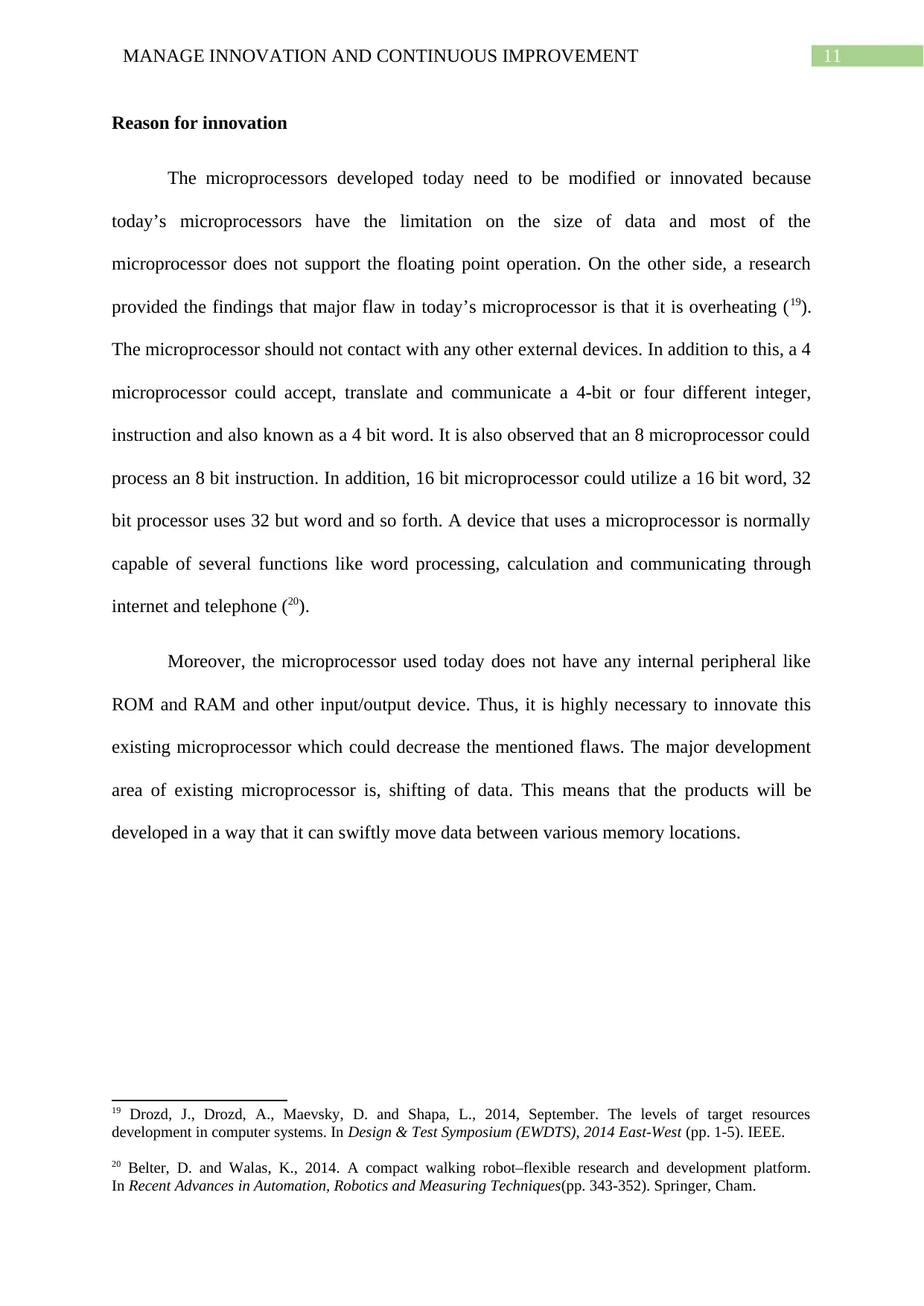
11MANAGE INNOVATION AND CONTINUOUS IMPROVEMENT
Reason for innovation
The microprocessors developed today need to be modified or innovated because
today’s microprocessors have the limitation on the size of data and most of the
microprocessor does not support the floating point operation. On the other side, a research
provided the findings that major flaw in today’s microprocessor is that it is overheating (19).
The microprocessor should not contact with any other external devices. In addition to this, a 4
microprocessor could accept, translate and communicate a 4-bit or four different integer,
instruction and also known as a 4 bit word. It is also observed that an 8 microprocessor could
process an 8 bit instruction. In addition, 16 bit microprocessor could utilize a 16 bit word, 32
bit processor uses 32 but word and so forth. A device that uses a microprocessor is normally
capable of several functions like word processing, calculation and communicating through
internet and telephone (20).
Moreover, the microprocessor used today does not have any internal peripheral like
ROM and RAM and other input/output device. Thus, it is highly necessary to innovate this
existing microprocessor which could decrease the mentioned flaws. The major development
area of existing microprocessor is, shifting of data. This means that the products will be
developed in a way that it can swiftly move data between various memory locations.
19 Drozd, J., Drozd, A., Maevsky, D. and Shapa, L., 2014, September. The levels of target resources
development in computer systems. In Design & Test Symposium (EWDTS), 2014 East-West (pp. 1-5). IEEE.
20 Belter, D. and Walas, K., 2014. A compact walking robot–flexible research and development platform.
In Recent Advances in Automation, Robotics and Measuring Techniques(pp. 343-352). Springer, Cham.
Reason for innovation
The microprocessors developed today need to be modified or innovated because
today’s microprocessors have the limitation on the size of data and most of the
microprocessor does not support the floating point operation. On the other side, a research
provided the findings that major flaw in today’s microprocessor is that it is overheating (19).
The microprocessor should not contact with any other external devices. In addition to this, a 4
microprocessor could accept, translate and communicate a 4-bit or four different integer,
instruction and also known as a 4 bit word. It is also observed that an 8 microprocessor could
process an 8 bit instruction. In addition, 16 bit microprocessor could utilize a 16 bit word, 32
bit processor uses 32 but word and so forth. A device that uses a microprocessor is normally
capable of several functions like word processing, calculation and communicating through
internet and telephone (20).
Moreover, the microprocessor used today does not have any internal peripheral like
ROM and RAM and other input/output device. Thus, it is highly necessary to innovate this
existing microprocessor which could decrease the mentioned flaws. The major development
area of existing microprocessor is, shifting of data. This means that the products will be
developed in a way that it can swiftly move data between various memory locations.
19 Drozd, J., Drozd, A., Maevsky, D. and Shapa, L., 2014, September. The levels of target resources
development in computer systems. In Design & Test Symposium (EWDTS), 2014 East-West (pp. 1-5). IEEE.
20 Belter, D. and Walas, K., 2014. A compact walking robot–flexible research and development platform.
In Recent Advances in Automation, Robotics and Measuring Techniques(pp. 343-352). Springer, Cham.

12MANAGE INNOVATION AND CONTINUOUS IMPROVEMENT
References
Acar, A. and Acar, P., 2014. Organizational culture types and their effects on organizational
performance in Turkish hospitals. Emerging Markets Journal, 3(3), p.18.
Bocken, N.M., Short, S.W., Rana, P. and Evans, S., 2014. A literature and practice review to
develop sustainable business model archetypes. Journal of cleaner production, 65, pp.42-56.
Chambers, N., Simmons, C. and Wackernagel, M., 2014. Sharing nature's interest:
ecological footprints as an indicator of sustainability. Routledge
Chen, J.C., Li, Y. and Shady, B.D., 2010. From value stream mapping toward a lean/sigma
continuous improvement process: an industrial case study. International Journal of
Production Research, 48(4), pp.1069-1086.
Drozd, J., Drozd, A., Maevsky, D. and Shapa, L., 2014, September. The levels of target
resources development in computer systems. In Design & Test Symposium (EWDTS), 2014
East-West (pp. 1-5). IEEE.
Hansen, E.G. and Schaltegger, S., 2016. The sustainability balanced scorecard: A systematic
review of architectures. Journal of Business Ethics, 133(2), pp.193-221.
Intra, C. and Zahn, T., 2014. Transformation-waves–a brick for a powerful and holistic
continuous improvement process of a Lean production system. Procedia CIRP, 17, pp.582-
587.
Klinglmair, M., Sala, S. and Brandão, M., 2014. Assessing resource depletion in LCA: a
review of methods and methodological issues. The International Journal of Life Cycle
Assessment, 19(3), pp.580-592.
Kumar, N., 2017. Milestones in Business Ethics. Journal of Industrial Relationship,
Corporate Governance & Management Explorer (e ISSN 2456-9461), 1(1), pp.26-32.
References
Acar, A. and Acar, P., 2014. Organizational culture types and their effects on organizational
performance in Turkish hospitals. Emerging Markets Journal, 3(3), p.18.
Bocken, N.M., Short, S.W., Rana, P. and Evans, S., 2014. A literature and practice review to
develop sustainable business model archetypes. Journal of cleaner production, 65, pp.42-56.
Chambers, N., Simmons, C. and Wackernagel, M., 2014. Sharing nature's interest:
ecological footprints as an indicator of sustainability. Routledge
Chen, J.C., Li, Y. and Shady, B.D., 2010. From value stream mapping toward a lean/sigma
continuous improvement process: an industrial case study. International Journal of
Production Research, 48(4), pp.1069-1086.
Drozd, J., Drozd, A., Maevsky, D. and Shapa, L., 2014, September. The levels of target
resources development in computer systems. In Design & Test Symposium (EWDTS), 2014
East-West (pp. 1-5). IEEE.
Hansen, E.G. and Schaltegger, S., 2016. The sustainability balanced scorecard: A systematic
review of architectures. Journal of Business Ethics, 133(2), pp.193-221.
Intra, C. and Zahn, T., 2014. Transformation-waves–a brick for a powerful and holistic
continuous improvement process of a Lean production system. Procedia CIRP, 17, pp.582-
587.
Klinglmair, M., Sala, S. and Brandão, M., 2014. Assessing resource depletion in LCA: a
review of methods and methodological issues. The International Journal of Life Cycle
Assessment, 19(3), pp.580-592.
Kumar, N., 2017. Milestones in Business Ethics. Journal of Industrial Relationship,
Corporate Governance & Management Explorer (e ISSN 2456-9461), 1(1), pp.26-32.
Paraphrase This Document
Need a fresh take? Get an instant paraphrase of this document with our AI Paraphraser
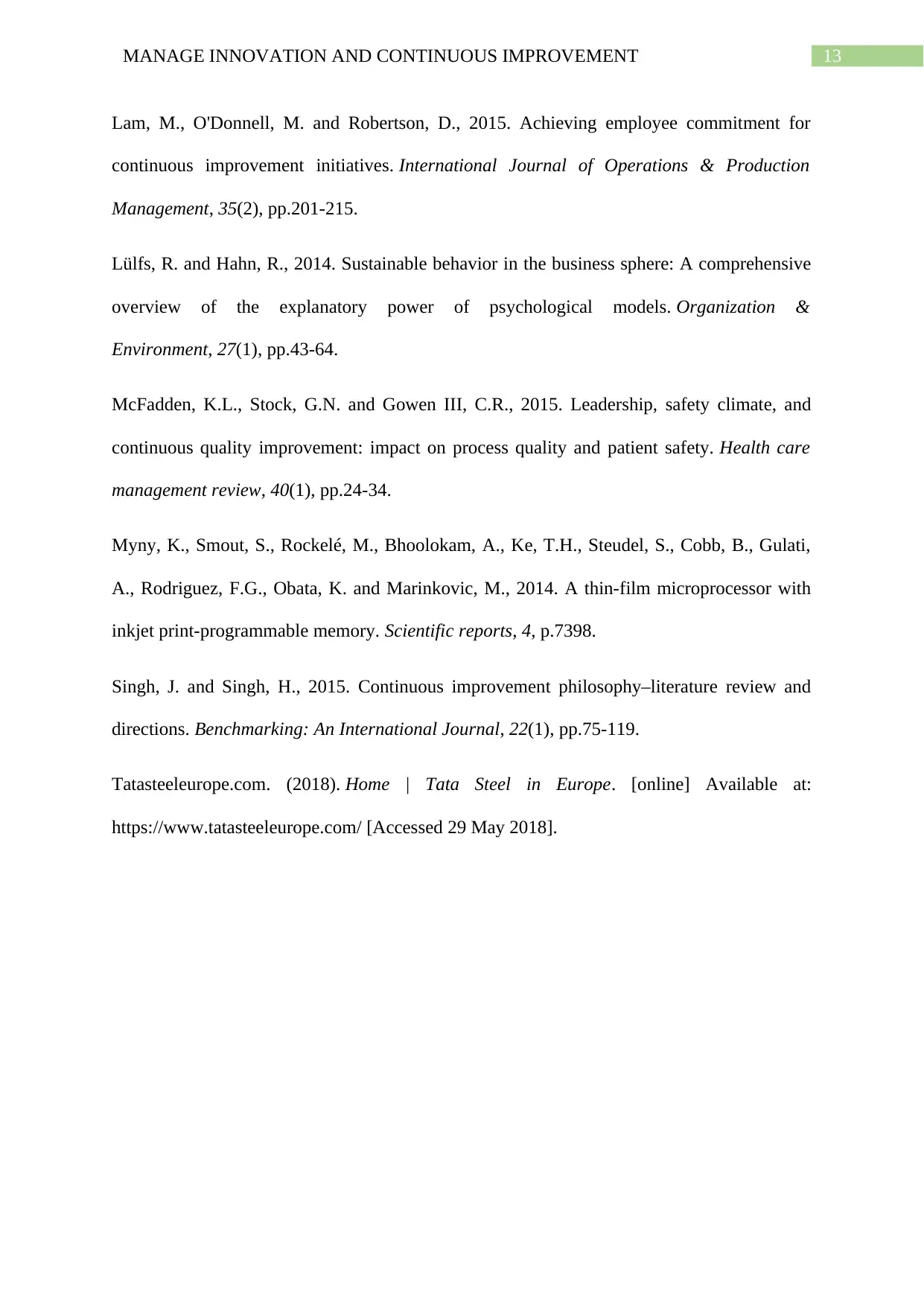
13MANAGE INNOVATION AND CONTINUOUS IMPROVEMENT
Lam, M., O'Donnell, M. and Robertson, D., 2015. Achieving employee commitment for
continuous improvement initiatives. International Journal of Operations & Production
Management, 35(2), pp.201-215.
Lülfs, R. and Hahn, R., 2014. Sustainable behavior in the business sphere: A comprehensive
overview of the explanatory power of psychological models. Organization &
Environment, 27(1), pp.43-64.
McFadden, K.L., Stock, G.N. and Gowen III, C.R., 2015. Leadership, safety climate, and
continuous quality improvement: impact on process quality and patient safety. Health care
management review, 40(1), pp.24-34.
Myny, K., Smout, S., Rockelé, M., Bhoolokam, A., Ke, T.H., Steudel, S., Cobb, B., Gulati,
A., Rodriguez, F.G., Obata, K. and Marinkovic, M., 2014. A thin-film microprocessor with
inkjet print-programmable memory. Scientific reports, 4, p.7398.
Singh, J. and Singh, H., 2015. Continuous improvement philosophy–literature review and
directions. Benchmarking: An International Journal, 22(1), pp.75-119.
Tatasteeleurope.com. (2018). Home | Tata Steel in Europe. [online] Available at:
https://www.tatasteeleurope.com/ [Accessed 29 May 2018].
Lam, M., O'Donnell, M. and Robertson, D., 2015. Achieving employee commitment for
continuous improvement initiatives. International Journal of Operations & Production
Management, 35(2), pp.201-215.
Lülfs, R. and Hahn, R., 2014. Sustainable behavior in the business sphere: A comprehensive
overview of the explanatory power of psychological models. Organization &
Environment, 27(1), pp.43-64.
McFadden, K.L., Stock, G.N. and Gowen III, C.R., 2015. Leadership, safety climate, and
continuous quality improvement: impact on process quality and patient safety. Health care
management review, 40(1), pp.24-34.
Myny, K., Smout, S., Rockelé, M., Bhoolokam, A., Ke, T.H., Steudel, S., Cobb, B., Gulati,
A., Rodriguez, F.G., Obata, K. and Marinkovic, M., 2014. A thin-film microprocessor with
inkjet print-programmable memory. Scientific reports, 4, p.7398.
Singh, J. and Singh, H., 2015. Continuous improvement philosophy–literature review and
directions. Benchmarking: An International Journal, 22(1), pp.75-119.
Tatasteeleurope.com. (2018). Home | Tata Steel in Europe. [online] Available at:
https://www.tatasteeleurope.com/ [Accessed 29 May 2018].
1 out of 14
Related Documents
Your All-in-One AI-Powered Toolkit for Academic Success.
+13062052269
info@desklib.com
Available 24*7 on WhatsApp / Email
![[object Object]](/_next/static/media/star-bottom.7253800d.svg)
Unlock your academic potential
© 2024 | Zucol Services PVT LTD | All rights reserved.





